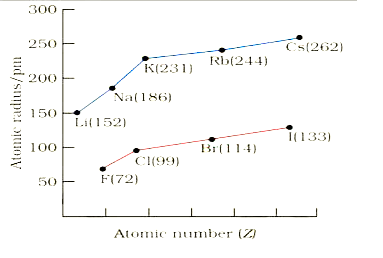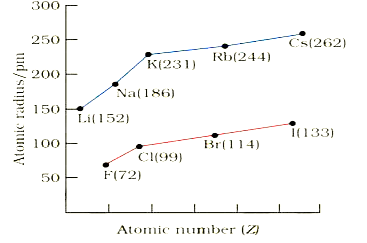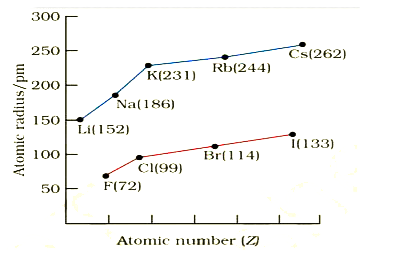Electropositive or metallic character
increases in a period
decreases in a group
decreases in a period and increases in a group
of an element is reflected in its tendency to form covalent compounds.
The correct Answer is:C
decreases in a period and increases in a group
Similar Questions
Electro positivity : Metallic character : : .. .. , .... ... : Non-metallic character.
View SolutionFill in the blanks with the appropriate word/s
Across a period, the electropositive character character _______and down a group the electronegative character ________ [increases/decreases]
View Solution
Knowledge Check
Metallic Character
The ability of an atom to donate electrons and form positive ion (cation) is known as electropositivity or metallic character. Down the group, metallic character increases due to increase in atomic size and across the period, from left to right electropositivity decreases due to decrease in atomic size.
Non-Metallic Character
The ability of an atom to accept electrons to form a negative ion (anion) is called non-metallic character or electronegativity. The elements having high electro-negativity have a higher tendency to gain electrons and form anion. Down the group, electronegativity decreases due to increase in atomic size and across the period, from left to right electronegativity increases due to decrease in atomic size

Which of the following correctly represents the decreasing order of metallic character of Alkali metals plotted in the graph?ACs>Rb>Li>Na>KBK>Rb>Li>Na>CsCCs>Rb>K>Na>LiDCs>K>Rb>Na>LiMetallic Character
The ability of an atom to donate electrons and form positive ion (cation) is known as electropositivity or metallic character. Down the group, metallic character increases due to increase in atomic size and across the period, from left to right electropositivity decreases due to decrease in atomic size.
Non-Metallic Character
The ability of an atom to accept electrons to form a negative ion (anion) is called non-metallic character or electronegativity. The elements having high electro-negativity have a higher tendency to gain electrons and form anion. Down the group, electronegativity decreases due to increase in atomic size and across the period, from left to right electronegativity increases due to decrease in atomic size

Which of the following has highest electronegativity?AFBClCBrDIMetallic Character
The ability of an atom to donate electrons and form positive ion (cation) is known as electropositivity or metallic character. Down the group, metallic character increases due to increase in atomic size and across the period, from left to right electropositivity decreases due to decrease in atomic size.
Non-Metallic Character
The ability of an atom to accept electrons to form a negative ion (anion) is called non-metallic character or electronegativity. The elements having high electro-negativity have a higher tendency to gain electrons and form anion. Down the group, electronegativity decreases due to increase in atomic size and across the period, from left to right electronegativity increases due to decrease in atomic size

Which of the following reason correctly justifies that “Fluorine (72pm) has smaller atomic radius than Lithium (152pm)”?AF and Li are in the same group. Atomic size increases down the groupBF and Li are in the same period. Atomic size increases across the period due to increase in number of shellsCF and Li are in the same group. Atomic size decreases down the groupDF and Li are in the same period and across the period atomic size/radius decreases from left to right.
Which of the following metal is highest electropositive (metallic) in nature?
View SolutionMetallic Character
The ability of an atom to donate electrons and form positive ion (cation) is known as electropositivity or metallic character. Down the group, metallic character increases due to increase in atomic size and across the period, from left to right electropositivity decreases due to decrease in atomic size.
Non-Metallic Character
The ability of an atom to accept electrons to form a negative ion (anion) is called non-metallic character or electronegativity. The elements having high electro-negativity have a higher tendency to gain electrons and form anion.Down the group, electronegativity decreases due to increase in atomic size andacross the period, from left to right electronegativity increases due to decreasein atomic size

Identify the reason for the gradual change in electronegativity in halogensdown the group.
View SolutionMetallic Character
The ability of an atom to donate electrons and form positive ion (cation) is known as electropositivity or metallic character. Down the group, metallic character increases due to increase in atomic size and across the period, from left to right electropositivity decreases due to decrease in atomic size.
Non-Metallic Character
The ability of an atom to accept electrons to form a negative ion (anion) is called non-metallic character or electronegativity. The elements having high electro-negativity have a higher tendency to gain electrons and form anion.Down the group, electronegativity decreases due to increase in atomic size and across the period, from left to right electronegativity increases due to decrease in atomic size

Hydrogen is placed along with Alkali metals in the modern periodic table though it shows non-metallic character
View SolutionWhich of the following metal is highest electropositive (metallic) in nature?
View SolutionWhich of the following metal is highest electropositive (metallic) in nature?
View Solution
